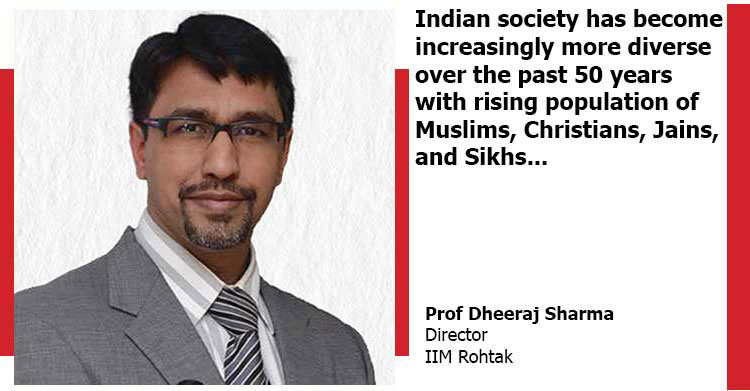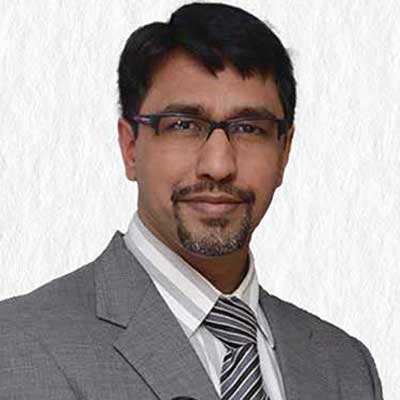Process of Acculturation In Indian Society: Majority vs Minority View | Prof Dheeraj Sharma | Director | IIM Rohtak

Indian society has become increasingly more diverse over the past 50 years with rising population of Muslims, Christians, Jains, and Sikhs. The meaning and quality of intergroup relations between different religious groups within the country reflect distinct socio-cultural, historical, and political frameworks. The host group orientations towards the religious groups seems to a change in the last few years. Consequently, a study was undertaken to examine adaptability between religious groups. A survey was conducted amongst 2012 respondents. 821 Hindu, 447 Muslims, 399 Sikhs and 345 Christians. First, the respondents were asked to provide their likelihood of using other religious greetings. Specifically, the respondents were asked when they met an individual from different religion how likely were they do use the religious greeting of that person. In other words, the Hindu respondent is to respond “When I meets a Muslim person I wish the person “Aslam-o-Alykum”. The answer is on a seven point Likert type scale ranging from very likely to very unlikely. Similarly, a Muslim respondent is to respond “When I meets a Hindu person I wish the person “Namaskar”. Similarly, responses of respondents from other religion were recorded. The responses were interesting. On an average 82% of the Hindu respondents suggest that they were likely or very likely to use the other person’s religious greeting. On an average 74% of the Christians respondents suggest that they were likely or very likely to use the other person’s religious greeting. On an average 41% of the Sikhs respondents suggest that they were likely or very likely to use the other person’s religious greeting. On an average 18% of the Muslim respondents suggest that they were likely or very likely to use the other person’s religious greeting. On an average 62% of the Hindu respondents suggest that they were likely or very likely celebrate the festival of people of other religions. On an average 34% of the Christians respondents suggest that they were likely or very likely celebrate the festival of people of other religions. On an average 51% of the Sikhs respondents suggest that they were likely or very likely celebrate the festival of people of other religions. On an average 12% of the Muslims respondents suggest that they were likely or very likely celebrate the festival of people of other religions.
These acculturation expectations of the majority group differ largely from what minority members themselves want and this disagreement may result in inter-group tensions and conflict. It is important therefore to study where majority members’ expectations concerning the acculturation of members of a minority group come from. Second, it is important to examine why these expectation have built up. Knowledge of these antecedents may offer possibilities to alter majority members’ expectations and to bridge the gap between the positions of the host group and this minority group. Also, the understanding of the reticence of minority group to acculturate may also result in some policy level interventions that could create a better milieu of society so that minorities can better fit the larger society.
Therefore, the survey measured majority members’ (Hindus) expectations concerning the acculturation of people belonging to other religious denominations. These results are even more interesting. The majority members have relatively low expectations from the others to exhibit acculturation. However, there is significant difference in the expectations across generations for the majority members. In other words, expectation are low for majority member in age group higher than 55 years. The expectation are fairly high for the majority member in the age group between 25 to 44 years.
Next, we inquired in the survey if the respondent felt that their religion permits accommodation for other religions. Nearly 84% of the Hindus felt that their religion was permits accommodating of other religions. The number dwindled for other religions. For instance, the number for Muslims was 8% and for Christians it was 15%. However, for Sikhs the number was 96%. Contrarily, when we inquired “how accommodative other religions were towards their religion?” Hindus responded that 28% of people following other religions provided accommodation for Hindu religious practices, rituals, acts, and events. Muslims responded that 29% of people following other religions provided accommodation for Muslim religious practices, rituals, acts, and events. Christians responded that 54% of people following other religions provided accommodation for Christian religious practices, rituals, acts, and events. Sikhs responded that 77% of people following other religions provided accommodation for Sikh religious practices, rituals, acts, and events. Finally, we inquired are you willing to accommodate the practices, rituals, acts, and events of people belonging to specific religions. The results are summarized in the table below:
Religion/Accommodation Hindu Muslim Christian Sikh
Hindu 94% 23% 44% 94%
Muslim 4% 94% 29% 5%
Christian 8% 10% 99% 7%
Sikh 86% 2% 5% 100%
Possible reasons of variance in expectation across age is due to higher information access amongst the youth related to various history facts, legends, stories, folklores, etc via social media. In other words, the youth has more information related to various historic events and have come realize the possible level of accommodation that the majority members have been making. However, the majority now feel that that the minority has little to no appreciation for the accommodations. Further, the minority seems to have desire for more. Additionally, the minority itself is unwilling to accommodate. In other words, the table above clearly indicates that majority is accommodating more than minority. This evident from the fact that while there has not been any large scale exodus of minorities from Hindu dominated states but we have at least witnessed two major exodus from non-Hindu states in India. Sikh migration to Punjab from other states including Delhi post 1984 was not in very large numbers despite serious maltreatment and killing of Sikhs in days following Prime Minister Indira Gandhi’s assassination in 1984.
First, the exodus of Hindus between 1981-84 from Punjab who then majorly settled in several part of Haryana and Delhi. Many contend that city of Panchkula became heavily populated due to migration of Hindus from part of Punjab. Second, the exodus of Hindus from Kashmir valley in 1989-90, who majorly settled in Jammu and Delhi. Several areas in Delhi even today are heavily populated by migrants from Kashmir. Accommodation for others may be the right thing to do but what is the optimum level of accommodation.
Future studies need to examine the same. However, it is evident that there seems to be a significant difference between the level of accommodation of the majority and minority. This is possibly the reason that the youth of the majority seems to feel that accommodation has become a more or less one way street. Information and disinformation campaign through social media and messaging services only aid to development of harder positions amongst the youth. However, a peaceful society, it is best when both majority and minorities make accommodation for each other. Minorities may need to be dealt with care as they do not have large numbers to possibly make their points sufficiently but at the same time leaders of minorities must actively participate in the activities of majority to demonstrate that there is flexibility in their approach and way of life. Only then we can expect true acculturation in the society for peace and progress.


